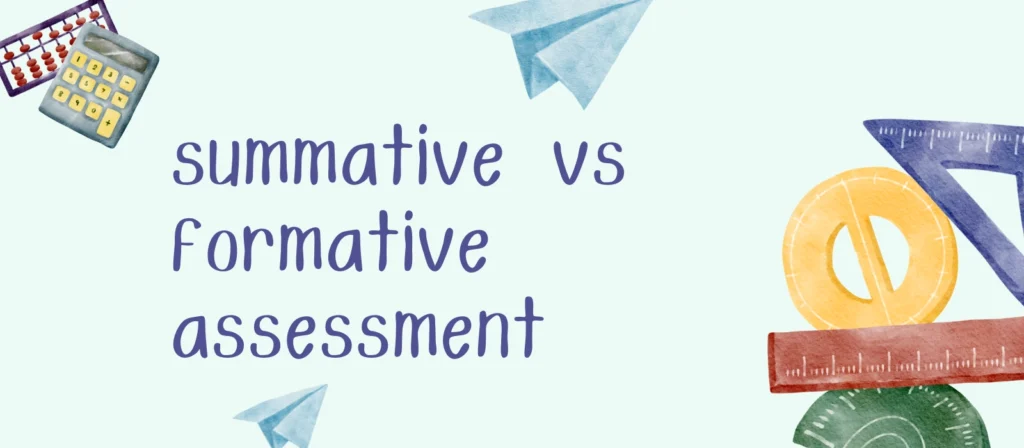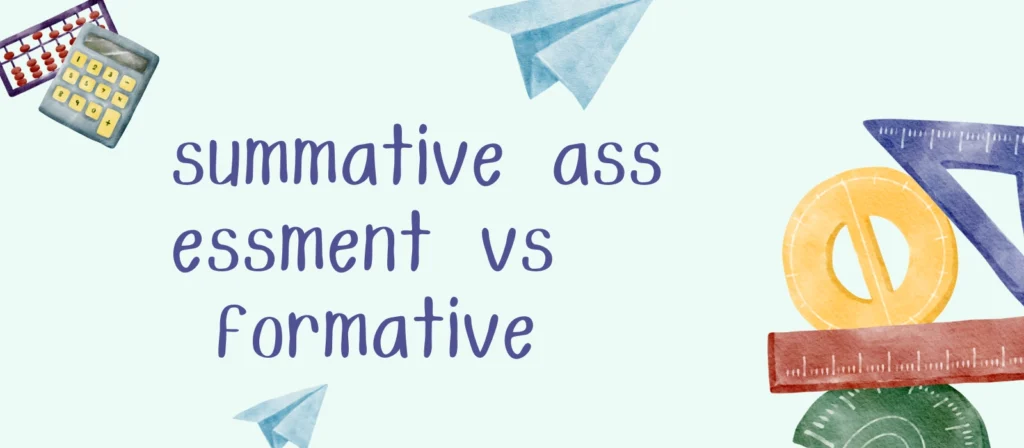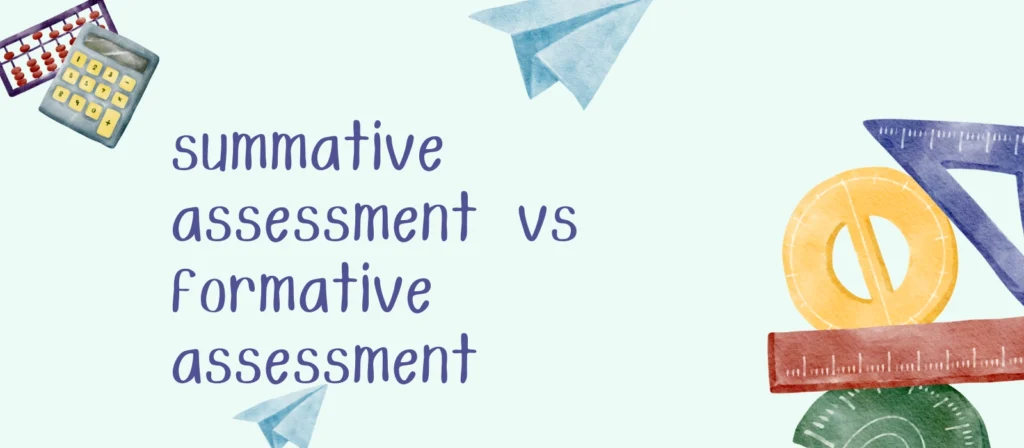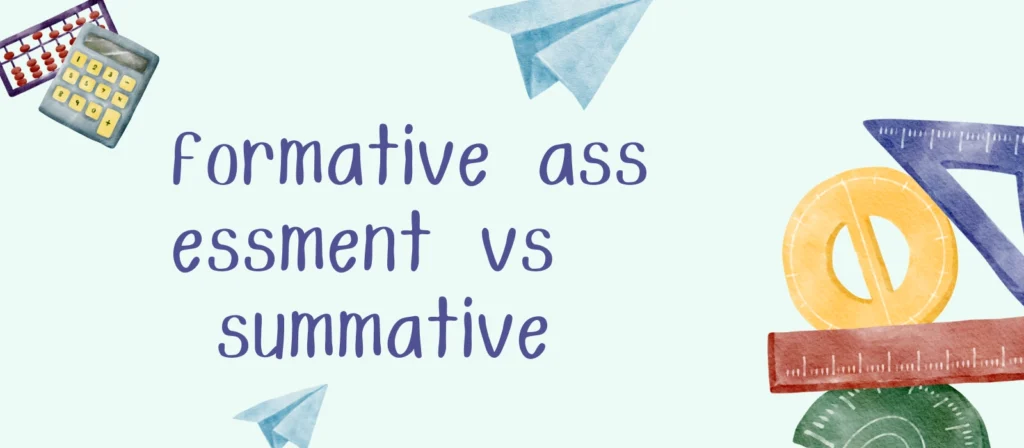In education, one of the most important aspects of fostering student development is the process of assessment. As educators, we need to constantly evaluate how well students are progressing in their learning journey. This evaluation not only helps us identify gaps in knowledge but also allows us to refine teaching methods to meet individual student needs. But with so many different types of assessments available, it can be difficult to choose the right one for each situation. So, what is the difference between formative assessment vs summative assessment, and why does it matter? The answer lies in their different purposes and timing.
Formative assessments are used throughout the learning process to provide ongoing feedback to students, helping them understand their strengths and areas for improvement. Summative assessments, on the other hand, occur at the end of an instructional period and are used to evaluate students’ final understanding and achievements. Both play critical roles in student development, but understanding when and why to use each is crucial for fostering an environment of continuous learning.
By combining formative assessment vs summative assessment, educators can create a balanced system that not only measures student performance but also supports their growth throughout the learning process. This combination ensures that students are continuously improving while also providing a final evaluation of their academic progress. In the following sections, we will explore how each type of assessment works, why it is important, and how they can be used effectively to enhance learning outcomes.
Overview of Assessment Types
In the field of education, assessments are essential tools that help measure and track students’ learning progress. They provide valuable insights into student understanding, skills, and areas where improvement is needed. There are many different types of assessments, each serving a unique purpose and offering various benefits to both students and educators. These assessments can be broadly categorized into several types, including Formative Assessment, Summative Assessment, Diagnostic Assessment, Ipsative Assessment, Norm-Referenced Assessment, and Criterion-Referenced Assessment.
Each assessment type plays a specific role in the learning process. Formative Assessments are conducted during the learning process to provide ongoing feedback, while Summative Assessments are used at the end of an instructional period to evaluate overall performance. Other types, such as Diagnostic Assessments, help identify students’ prior knowledge before instruction begins, and Ipsative Assessments track individual progress over time. Norm-Referenced Assessments compare students’ performance to that of their peers, while Criterion-Referenced Assessments focus on whether students meet specific learning objectives, independent of how others perform.
In the sections that follow, we will dive deeper into each of these assessment types to better understand their purpose, benefits, and how they contribute to a comprehensive educational experience.
1. Formative Assessment
Formative Assessment refers to a range of informal and formal assessments conducted during the learning process to monitor student progress. These assessments provide immediate feedback to both students and teachers, allowing for real-time adjustments to teaching methods and learning strategies. Common examples of formative assessments include quizzes, class discussions, polls, or homework assignments.
The main purpose of formative assessment is to identify learning gaps early on so that students can improve their understanding before it is too late. It helps teachers recognize which areas need more focus and allows students to correct mistakes and enhance their learning. By offering continuous feedback, formative assessments foster a more engaged and active learning environment.
2. Summative Assessment
Summative Assessment is used to evaluate student learning at the end of an instructional period, such as the end of a lesson, unit, or academic year. These assessments are often high-stakes, contributing significantly to final grades. The goal of summative assessments is to provide a final judgment on a student’s performance based on what they have learned throughout the course.
Examples of summative assessments include final exams, end-of-term projects, and standardized tests. Summative assessments are typically designed to assess a student’s overall mastery of the material covered and determine if they meet the course’s learning objectives. While they are useful for evaluating student achievement, summative assessments do not provide immediate feedback for improvement.
3. Diagnostic Assessment
Diagnostic Assessment is a type of assessment conducted before or at the beginning of a learning period to understand a student’s prior knowledge, skills, and learning needs. It aims to identify gaps in understanding, learning disabilities, or areas where students might need additional support before instruction begins.
For example, a pre-test before starting a unit on fractions could be used to determine students’ existing knowledge of basic math concepts. Diagnostic assessments help educators tailor their instruction to meet the specific needs of each student, ensuring that all learners start on the right foot.
4. Ipsative Assessment
Ipsative Assessment measures a student’s current performance against their past achievements. Rather than comparing students to others, this form of assessment focuses on an individual’s progress over time. Ipsative assessments emphasize personal growth and improvement, which can be a powerful motivator for students.
An example of ipsative assessment might be a student who tracks their scores on practice tests over the course of a semester. If the student shows improvement compared to their own past performance, it indicates progress, regardless of how others perform. This type of assessment is valuable for encouraging self-reflection and motivation.
5. Norm-Referenced Assessment
Norm-Referenced Assessment compares a student’s performance to that of a larger group of students, often a class, school, or district. This type of assessment is useful for ranking students and understanding where they stand in comparison to their peers. Standardized tests are a prime example of norm-referenced assessments, as they are designed to measure students’ performance against a national or international standard.
While norm-referenced assessments can provide useful data for understanding student performance relative to others, they have limitations. For instance, they may not accurately reflect a student’s understanding of the material, as performance depends on how well others perform as well.
6. Criterion-Referenced Assessment
Criterion-Referenced Assessment measures how well a student has mastered specific learning objectives or skills, independent of how their peers perform. Unlike norm-referenced assessments, which rank students, criterion-referenced assessments focus on whether a student has achieved a set standard or met the required criteria.
An example of criterion-referenced assessment is a certification exam, where students either pass or fail based on their ability to meet the established criteria. This type of assessment is especially valuable in determining if a student has acquired the necessary knowledge or skills to proceed to the next level.

Formative Assessment vs Summative Assessment
What is a Formative Assessment?
Formative Assessment refers to a wide range of informal and formal assessments conducted during the learning process. The primary purpose of formative assessments is to monitor student learning, provide feedback, and guide both teachers and students toward improving learning outcomes. Unlike summative assessments, which evaluate final results, formative assessments focus on understanding students’ progress and adjusting instruction as needed.
These assessments occur throughout the learning experience, providing an ongoing check on students’ understanding and skills. They can take various forms, such as quizzes, class discussions, observations, homework assignments, or peer reviews. The aim is not to assign grades but to gather data that can help teachers identify which concepts students have mastered and which areas require further attention. By continuously assessing students, educators can make real-time adjustments to teaching strategies and provide targeted support for individual learners.
Formative assessments are crucial for guiding the learning process. They help students engage with the material and reflect on their own progress, giving them an opportunity to improve before final evaluations take place. This ongoing assessment ensures that students are not left behind and that their learning journey is continuously supported.
The Importance of Formative Assessment
The importance of Formative Assessment lies in its ability to provide immediate, actionable feedback that helps students improve throughout the learning process. This type of assessment allows students to identify areas where they are struggling and offers them the chance to correct mistakes before they become ingrained. It also promotes a more interactive and student-centered learning environment, where students actively engage in their own learning and take ownership of their progress.
Formative assessments enable teachers to track students’ understanding in real-time, offering insights that can guide instructional adjustments. For example, if a teacher notices that many students are struggling with a particular concept, they can modify their lesson plan to revisit that topic or provide additional resources. Additionally, formative assessments give students a clear picture of their own learning, helping them understand what they need to focus on and how they can improve.
By fostering a continuous feedback loop, formative assessments support both student growth and effective teaching. They promote learning as an evolving process rather than a one-time evaluation, ultimately leading to improved outcomes for all students.
What is a Summative Assessment?
Summative Assessment refers to assessments that occur at the end of a learning period, such as the end of a lesson, unit, semester, or academic year. These assessments are designed to evaluate the cumulative knowledge and skills that students have acquired throughout the course. Unlike formative assessments, which provide ongoing feedback, summative assessments are used to assess students’ final achievement and overall performance.
Summative assessments can take many forms, including final exams, standardized tests, final projects, or presentations. These assessments are typically high-stakes, with their results often contributing significantly to students’ final grades. The primary purpose of summative assessments is to determine whether students have met the learning objectives and to provide a final evaluation of their understanding of the material.
While summative assessments provide a comprehensive measure of students’ academic progress, they do not offer the same ongoing feedback that formative assessments provide. Instead, they offer a snapshot of what students have learned and serve as a final judgment of their performance in relation to the course’s goals.
The Importance of Summative Assessment
The significance of Summative Assessment lies in its ability to provide a final, conclusive evaluation of students’ learning and academic achievement. These assessments offer valuable insights into how well students have mastered the content and whether they have met the required learning standards. For educators, summative assessments provide a way to measure the overall effectiveness of their teaching strategies and determine whether their instructional goals have been met.
Summative assessments also play a crucial role in accountability. They are often used to assign grades, which can impact students’ academic standing and future opportunities. Additionally, these assessments provide parents, administrators, and policymakers with a clear picture of student performance and can inform decisions about curriculum and program effectiveness.
While summative assessments do not provide ongoing feedback, they are essential in gauging whether students have achieved the desired learning outcomes. They help educators assess the success of their teaching and ensure that students are prepared for future academic challenges.

Practical Examples of Formative Assessment vs Summative Assessment
Common Forms of Formative Assessment
Formative Assessment is primarily focused on providing continuous feedback to help students improve during the learning process. There are several common methods used for formative assessment that can help teachers gauge student progress and adjust their teaching strategies in real-time.
One common form of Formative Assessment is quizzes. Quizzes, whether formal or informal, allow teachers to check student understanding on a specific topic or skill. These quizzes are not high-stakes, meaning they are used more to assess knowledge retention and identify gaps in understanding, rather than assigning final grades. For example, a short quiz after each lesson can quickly highlight which students need additional help or which concepts need to be revisited.
Another effective form of Formative Assessment is peer reviews. In this method, students review each other’s work and provide constructive feedback. This not only encourages collaboration and communication among students but also gives them a deeper understanding of the subject matter. Peer reviews allow students to see different perspectives, which can help them refine their ideas and improve their work before a final submission.
Teacher observations are also widely used in Formative Assessment. During class activities or discussions, teachers can observe students’ engagement, participation, and understanding. These observations provide real-time insights into how well students are grasping concepts and can help teachers adjust their approach if necessary. For instance, if a teacher notices a student is confused during a discussion, they can provide immediate clarification, ensuring the student is on the right track.
Finally, quick feedback during lessons, such as asking students to answer a question or provide a brief summary of the material, is another form of Formative Assessment. This type of feedback helps teachers understand whether students are following along and allows for immediate intervention if students are struggling with the material.
Common Forms of Summative Assessment
In contrast, Summative Assessment typically evaluates students’ cumulative learning at the end of a unit, term, or course. These assessments are used to gauge the overall effectiveness of the learning process and to determine whether students have achieved the necessary knowledge and skills.
One of the most common methods of Summative Assessment is the final exam. Final exams are designed to test a student’s comprehensive understanding of the material covered throughout a course. These assessments are typically high-stakes and contribute significantly to the student’s final grade. For example, a comprehensive exam at the end of a semester will assess all the topics the student has learned, testing their ability to recall and apply knowledge.
Standardized tests are another common example of Summative Assessment. These tests are administered to large groups of students to evaluate their performance against a set standard. Standardized tests are commonly used in schools to assess knowledge in specific subjects like math, reading, or science. The results of these tests provide valuable data for measuring student performance across districts, schools, or even countries, allowing for comparisons between different student populations.
End-of-term projects are also widely used as Summative Assessments. These projects allow students to apply what they have learned over the course of the term and demonstrate their ability to synthesize and analyze information. For example, a student might be tasked with a research paper or a multimedia presentation that showcases their understanding of a particular subject. These projects are often evaluated based on both content and presentation skills, providing a comprehensive assessment of the student’s learning.
Lastly, final presentations serve as another form of Summative Assessment. In many subjects, students are required to present their final projects or findings to their peers and instructors. These presentations are an opportunity for students to demonstrate their communication skills, as well as their understanding of the material. Final presentations are typically evaluated based on how well students convey their knowledge, the quality of their analysis, and the clarity of their delivery.

Purpose and Intent of Formative Assessment vs Summative Assessment
Objectives of Formative Assessment
The core objective of Formative Assessment is to provide ongoing feedback that supports student learning throughout the course or instructional period. Unlike Summative Assessment, which focuses on final evaluations, Formative Assessment is designed to guide and improve the learning process in real-time. It offers valuable insights for both teachers and students, enabling timely adjustments that ensure continuous progress and development.
One of the primary goals of Formative Assessment is to offer feedback for improvement. Rather than simply evaluating student performance, formative assessments highlight areas where students can enhance their understanding and skills. For example, after a quiz or written assignment, teachers can provide specific feedback on how to improve in certain areas, helping students address weaknesses before they accumulate into larger learning gaps. This immediate feedback motivates students to continue learning and refining their skills.
Another critical objective of Formative Assessment is to diagnose student difficulties. Teachers can use these assessments to identify concepts that students are struggling with, allowing for early intervention. This diagnostic feedback helps ensure that students do not fall behind and that they are continuously building on a strong foundation. Whether through informal questioning or structured tests, formative assessments allow educators to monitor student progress regularly and take corrective actions as needed.
Additionally, Formative Assessment plays a crucial role in guiding future learning. The results from these assessments help inform the direction of subsequent lessons and activities. If a teacher discovers that a majority of students are having trouble with a specific concept, they can revisit the topic in more detail or introduce alternative teaching methods. This ongoing adjustment ensures that all students are given the tools and resources they need to succeed, fostering a more personalized learning experience.
Objectives of Summative Assessment
In contrast, the primary objective of Summative Assessment is to provide a conclusive evaluation of student learning at the end of a unit, term, or course. Summative Assessments are used to summarize and assess student achievement, offering a final judgment of their knowledge and skills based on the material they have learned throughout the course. These assessments are typically high-stakes, contributing significantly to a student’s final grade.
One of the main purposes of Summative Assessment is to measure the extent to which students have mastered the course content. For instance, a final exam assesses whether students can recall, apply, and synthesize the material they have studied over an extended period. Unlike formative assessments, which focus on guiding learning, summative assessments focus on evaluating the outcomes of learning, determining if the instructional objectives have been met.
Summative Assessment also serves as a tool for evaluating overall teaching effectiveness. By reviewing the results of summative assessments, teachers and administrators can assess whether the learning objectives for the course have been achieved and whether the teaching strategies employed were successful. This feedback helps inform decisions about curriculum development and instructional improvements, ensuring that the teaching process continually evolves to meet student needs.
Additionally, Summative Assessment is important for providing final judgments on student performance. These assessments offer an objective measure of a student’s academic progress, which can be used for various purposes, such as assigning grades, making promotion decisions, or determining eligibility for graduation. While Formative Assessment focuses on improvement and growth, summative assessments give a comprehensive picture of a student’s achievements and are often used for formal evaluations that impact their future educational opportunities.

Key Differences Between Formative Assessment vs Summative Assessment
Focus on Process vs Product
One of the key differences between formative and summative assessments lies in what they focus on: the process or the product. Formative assessment is primarily concerned with the learning process. It emphasizes continuous improvement and aims to guide students as they develop their understanding and skills over time. The goal is to support students in identifying areas where they need to improve and provide feedback that helps them progress.
In contrast, summative assessment focuses on the final product or outcome of student learning. These assessments occur at the end of a learning period and are used to evaluate the cumulative knowledge that students have gained. Summative assessments offer a snapshot of what students have learned after completing a course or unit and provide a judgment of their overall performance. While formative assessment helps shape the learning journey, summative assessment measures the end result.
Real-time Adjustments vs Final Evaluation
Another key distinction between formative and summative assessments is their role in making adjustments to teaching. Formative assessment allows educators to make real-time adjustments based on student progress. Teachers can use feedback gathered from formative assessments to modify lesson plans, introduce alternative teaching methods, or provide additional support to students who are struggling. This adaptability ensures that students stay on track and are given the necessary tools to succeed.
On the other hand, summative assessment serves as a final evaluation of student performance at the end of a learning period. It provides a comprehensive summary of what a student has achieved, and no further changes can be made once the assessment has been completed. Summative assessments provide a clear judgment of student learning, but they do not allow for immediate adjustments. They are often used for grading and official evaluations, offering a final assessment of student mastery.
Informative vs Judgmental Feedback
Formative assessment provides informative feedback that helps guide students’ learning. This feedback is constructive and aims to help students understand their strengths and weaknesses, offering actionable steps for improvement. Teachers use formative assessments to give students insights into their learning progress and suggest ways to enhance their understanding. The feedback from formative assessments is continuous and provides students with the opportunity to make adjustments before the final evaluation.
In contrast, summative assessment provides judgmental feedback based on the final outcome. It evaluates how well students have met the learning objectives and provides a final judgment of their performance. While formative feedback is meant to be a tool for improvement, summative feedback serves as an evaluative measure that influences final grades or decisions. The feedback from summative assessments is more conclusive and often focuses on the final result, rather than the learning process.
Ongoing vs Periodic
Formative assessment is conducted ongoing throughout the course or learning period. These assessments take place frequently and are spread out over time, providing continuous insights into student learning. By being conducted regularly, formative assessments allow educators to monitor student progress and make necessary adjustments to the teaching approach. The ongoing nature of formative assessments ensures that students receive consistent feedback, enabling them to stay on track throughout their learning journey.
In contrast, summative assessment is typically periodic, occurring at the end of a specific unit, term, or course. These assessments are less frequent and are used to evaluate student learning at a specific point in time. Summative assessments provide a final judgment of student performance after the learning process has been completed, making them a one-time evaluation of overall achievement. Unlike formative assessments, which are spread throughout the learning period, summative assessments are periodic and usually take place at the conclusion of an instructional period.
Pros and Cons: Formative Assessment vs Summative Assessment
Benefits of Formative Assessment
Formative assessment offers several significant benefits that contribute to a more personalized and dynamic learning experience. One of the primary advantages of formative assessment is that it provides immediate feedback to students. Unlike summative assessments, which evaluate student performance after a unit or course is complete, formative assessments give both students and teachers real-time insights into student progress. This immediate feedback allows students to understand their strengths and weaknesses, making it easier for them to adjust their learning strategies.
In addition to feedback, formative assessments support student engagement by encouraging active participation in the learning process. Because formative assessments occur frequently, they provide ongoing opportunities for students to demonstrate their understanding, engage in self-reflection, and adjust their learning approach accordingly. This continuous involvement increases student motivation and creates a more interactive classroom environment.
Another key benefit of formative assessment is its ability to enable personalized learning paths. Teachers can use the data from formative assessments to identify individual students’ needs and tailor instruction to meet those needs. Whether it’s offering additional support for students struggling with a particular topic or challenging those who excel, formative assessments help ensure that each student receives the attention and resources required for their academic growth.
Challenges of Formative Assessment
While formative assessments offer valuable benefits, they also come with certain challenges. One of the primary drawbacks is the time constraints they impose on teachers. Since formative assessments are conducted frequently, teachers must spend significant time creating, administering, and providing feedback on various assessment activities. This can be especially challenging for teachers managing large classes or heavy workloads, as the volume of assessments may become overwhelming.
Another challenge of formative assessments is managing large volumes of student data. Collecting and analyzing data from ongoing assessments can be time-consuming and complex, particularly in larger classrooms. Teachers need to ensure they are accurately tracking each student’s progress while identifying trends and making necessary adjustments to their instruction. Without an efficient system for managing this data, teachers may struggle to keep up with assessment results and provide timely feedback.
Lastly, maintaining consistent feedback across all students can be difficult. While formative assessments aim to provide ongoing and personalized feedback, ensuring that all students receive clear, actionable, and constructive comments can be challenging. Instructors may face difficulties in providing the level of detail needed for every student, especially when managing various assessment types and student needs simultaneously.
Benefits of Summative Assessment
Summative assessments provide clear advantages in terms of evaluating student performance. One of the primary benefits of summative assessments is that they provide a final, comprehensive measure of student achievement. After completing a course or unit, summative assessments summarize what students have learned, offering an overall assessment of their mastery of the material. This clarity and finality make summative assessments valuable for both students and educators in gauging how well learning objectives have been met.
Another key benefit of summative assessments is that they enable comparison across students. These assessments often involve standardized formats or grading rubrics, allowing educators to assess and compare student performance on the same scale. This comparative aspect makes it easier to identify high-performing students, as well as those who may need further support. It also helps maintain consistency in evaluating student performance across different classrooms, schools, or districts.
Summative assessments also guide final grading decisions, making them a crucial tool in determining students’ academic progress and success. These assessments serve as an official record of student achievement and play a significant role in final grades, graduation decisions, and overall academic outcomes. Summative assessments provide the necessary evidence for educational stakeholders to make decisions about student progression and achievement.
Challenges of Summative Assessment
Despite their advantages, summative assessments come with a number of challenges. One of the most significant issues is the potential for test anxiety. Since summative assessments are high-stakes, they often place considerable pressure on students to perform well. This anxiety can negatively impact their ability to demonstrate their true knowledge and skills, particularly if they struggle with test-taking environments or time constraints.
Another limitation of summative assessments is that they tend to focus solely on grades. While summative assessments do provide a final evaluation of student achievement, they often emphasize the outcome rather than the learning process. This can lead to students being overly focused on achieving a specific grade rather than engaging deeply with the content. Additionally, the grading system may not fully reflect the complexity of student learning or the efforts they have put into mastering the material.
Finally, summative assessments fail to capture ongoing learning efforts. Since they occur at the end of a learning period, summative assessments do not provide any feedback during the process of learning. This means that students who may have struggled earlier in the course but later made significant progress may not receive the recognition they deserve. Summative assessments focus on the final product, missing the opportunity to acknowledge students’ improvement throughout the learning journey.
Similarities Between Formative Assessment vs Summative Assessment
Despite their differences in timing, method, and purpose, Formative Assessment and Summative Assessment share a common goal: to enhance student learning and ensure that educational objectives are achieved. Both types of assessment are integral to the learning process, providing valuable insights into students’ progress and performance.
Both Formative Assessment and Summative Assessment aim to measure how well students are meeting the learning goals. While formative assessments focus on continuous feedback and improvement throughout the course, summative assessments provide a final measure of student achievement at the end. However, both types of assessments ultimately serve to evaluate whether students have mastered the content and met the set objectives.
Additionally, both assessments play a crucial role in informing educational decisions. For teachers, formative assessments guide ongoing instruction, helping to identify areas where students need further support or clarification. Summative assessments, on the other hand, provide a final evaluation of student performance, which can influence decisions about promotion, graduation, or further academic opportunities. Both forms of assessment offer essential data that informs teaching strategies, curriculum design, and educational outcomes.
Lastly, both Formative Assessment and Summative Assessment encourage accountability. Formative Assessment holds students accountable for their learning process, ensuring they engage with the material and make improvements along the way. Summative Assessment holds students accountable for their overall achievement, ensuring that they meet the required academic standards. Together, they create a balanced system that supports students’ continuous growth while also evaluating their final learning outcomes.
Conclusion
In conclusion, both formative and summative assessments play crucial roles in the educational process, albeit with different purposes and methods. Formative assessments are ongoing and provide continuous feedback, helping students improve during their learning journey. Summative assessments, on the other hand, offer a final evaluation of student achievement and measure overall success. While formative assessments focus on the learning process, summative assessments emphasize the final product.
By understanding the unique functions of each assessment type, educators can use them effectively to guide student development, track progress, and ensure that learning goals are met. A balanced approach, incorporating both formative and summative assessments, allows for a more comprehensive and supportive learning environment. Ultimately, these assessments work together to enhance student learning, promote continuous improvement, and ensure that academic standards are upheld.



